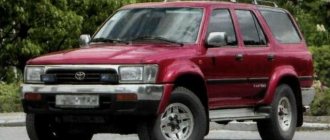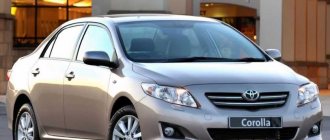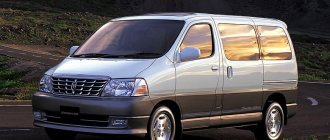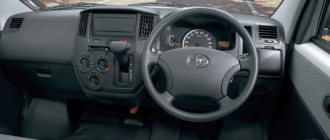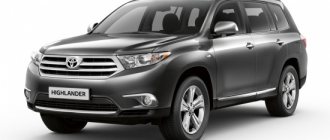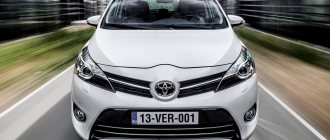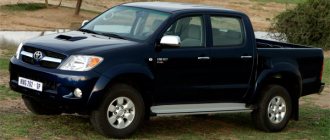Car appearance
It attracts attention with the harmonious proportions of the crossover.
The front bumper has a streamlined shape and is complemented by an aerodynamic “skirt”. The massive body kit protruding forward gives the car a slightly aggressive look.
LED fog lights are installed in neat recesses. The wide, distinctive air intake adds recognition to the car. In the side parts of the front bumper there are outlet openings for the brake disc ventilation channels.
The headlights are narrow and long, resembling squinted eyes. Lighting elements are created based on LED technology. The entire space between the head optics is occupied by the radiator grille. In its center there is a logo in the form of a harrier (this is how the word harrier is translated into Russian).
The appearance is characterized by harmonious proportions.
The rear of the body in the photo resembles an elegant pleasure boat. Its body kit, compared to the front one, protrudes less. The “slanted” taillights are connected to each other by a narrow reflective strip. The headlights protrude slightly back, which is typical for all Toyota models of recent generations.
Exterior design and colors
Compared to the previous version, the third is available in a shorter body. However, this did not make the car's appearance any less attractive. It is given elegance by a thin metal edging under the lower edges of the glass. Door handles are chromed or painted in body color.
The car was produced in 12 shades of colors - from pearl white to brown and ebony black.
Interior and cabin spaciousness
Despite the reduction in body length, capacity has increased compared to previous versions. The distance between the front and rear seats has increased by 47 mm. The trunk volume has increased by 17 liters and is 456 liters.
The interior of the cabin combines exquisite simplicity, luxury and nobility:
- The multimedia system display occupies most of the center console.
- Dual-zone climate control is controlled by touch buttons. Now you just need to lightly run your finger over them to set the desired temperature in the cabin.
- Blue night lighting looks pleasant and unobtrusive.
- The upholstery of the seats in different configurations is made of natural or artificial leather and high-quality textiles.
The interior of the cabin combines luxury and nobility.
A characteristic detail is the logo in the form of a harrier, embossed on the inner door trim.
Vehicle dimensions
The dimensions of the Toyota Harrier are shown in the table:
| Length/mm | 4720 |
| Body width/mm | 1835 |
| Height/mm | 1690 |
| Wheelbase width/mm | 2660 |
| Weight/kg | 1690 |
| Ground clearance/mm | 175-190 in different configurations |
| Tire parameters | 235/55R18 100H |
All owner reviews about Toyota Harrier XU10
What can I say, the car is good! There is something to compare with - due to the intricacies of life’s path, I had to work abroad in a company that sells and rents cars. Therefore, I drove most of the self-propelled vehicles of various types and purposes, including relatively expensive cars (40-80 thousand dollars), because they are very respected in Russia and were previously very actively bought (before the appearance of official dealers in our vast expanses ). Of course, this car cannot be compared with a heavy premium SUV like the Land Cruiser 100 (in terms of comfort, power and performance capabilities). I know that the Harrier does not belong to this class, but it has stuck in the mind as a standard among jeeps in terms of comfort-quality-cost and ease of use, as well as technical characteristics). It cannot be compared with such frankly more expensive and luxurious classmates as, for example, Porsche Cayenne or BMW X5. You can't, BUT! Find me an analogue in terms of price-quality-comfort ratio among the Japanese? And among the Germans? America? There is none of them! The appearance of this car is still a kind of standard when creating cars of this class. Why waste time on trifles, it was Toyota with its RX in 1998 (if memory serves) that made a kind of revolution in the minds of consumers and designers around the world. The resounding success of this car in the States forced the largest manufacturers to urgently develop analogue models of the RX. But, in my opinion, no one has managed to surpass the original in terms of its totality of qualities. Despite its more than venerable design, the car still looks stylish, modern and solid, and this is not an enthusiastic sob of a loving owner, but an objective remark based, among other things, on the reactions of others. Probably only Audi has such a lasting design success with its TT, which was produced for more than 10 years without any major changes.
Very decent interior. The front panel is made without pathos, but tastefully and stylishly. There is no angularity inherent in many “rogues”, everything is very elegant and solid. Soft plastic, good color scheme (in my model, the inserts on the panel are made in carbon fiber color. To my taste, this is much more interesting than the notorious wood in a high-tech product). Ergonomics are also excellent. There are a lot of electronics and buttons, but everything is intuitive and does not cause any difficulties during operation. I see a drawback in the absence of a sound control system on the steering wheel. Apparently in 2001 the Japs didn’t realize this... Using a computer and navigation (the touch panel is combined with a monitor) also does not cause any difficulties. The Japanese)) Seriously, they don’t use navigation in Russia due to its virtual absence, and the rest in my version is limited to the average consumption, the distance traveled and possible kilometers, and the temperature outside. As far as I was able to figure out, there are also functions of a service log, an organizer, games, music settings, maps indicating vacation spots, plus functions for controlling the audio system. I couldn’t figure out the rest)) Now all this can be translated into Russian and keep the work correct, but it costs $1,000. Is it worth it? The panel is good both day and night. Soft green color with bright green dots of activated functions, resting the eye. The instrument panel is optitron, snow-white when the ignition is on. Everything is perfectly readable both on a blindingly sunny day and at night (if it’s too bright, you can reduce the white intensity). The interior of this car is a separate issue. It is amazingly convenient, comfortable and very spacious. So much so that even my relatives, when they come to visit and transfer from the giant Range Rover, periodically note in surprise that, according to the subjective feeling, the interior in the Harrier is larger. The most comfortable front seats with folding armrests make a trip in a city traffic jam similar to watching widescreen TV at home in your favorite chair) Both rear and front passengers, with a height of 188, can sit completely calmly, without any inconvenience for the legs and everything else. Plus, the rear seats are folding, with a variable backrest angle, plus they move in length like the front ones. I have two children and I was able to fully appreciate these ergonomic delights. This is the only car for that kind of money where I could quite easily fit two child seats and my wife into the back seat without any embarrassment for the members of the company (seat belts are provided for three in the back seat). The wife is delighted). The trunk is also very spacious with fantastic options for transformation. If you fold down the rear seats, you can even take a downed cow away from the scene of the accident). Plus, the rising lower shelf in the trunk is fraught with a million recesses for all kinds of car accessories, which inevitably coexist with the car and the driver, usually turning into rattles rolling around the trunk or folded into a special box that occupies a quarter of the trunk. There is cleanliness and peace here. To be fair, it must be said that the drawers had to be sealed with noise so that the objects in them would not rattle while moving. Noise insulation and music at a high level. Of course, everything in the world is relative, but when I change to my dad’s Corolla, I get the persistent feeling that I’m in a tin can. Pebbles knocking on metal and clearly audible, the sound from the street, the sound of the engine, all this makes you passionately want to change back to the better one, which, as you know, you quickly get used to. About music. I really respect high-quality sound in a car and sincerely believe that bad music or its absence deprives a car of a significant portion of the thrill of driving. Therefore, I approach this issue meticulously. On previous cars, I tried for a long time to achieve a good sound, throwing away a lot of money on equipment, Shumka and the craftsmen who conjure up all this. But when I got into this car, I realized how a car should sound, in which the sound is made to a solid four (in the scenario where fives get cars voiced by real professionals for thousands or tens of thousands of dollars). Excellent ratio of high and low frequencies, perfectly working subwoofer. No, the numbers do not tremble from its thumping, the music being reproduced is simply heard harmoniously and fully. And this pleases the ear) And finally, the driving performance. I have a 2.4 engine - exactly the same one that is installed on the Camry. The Yaps installed it on the car after 2001 and owners complained that the 2.2 was too weak. With the relative weight of the cars, you can judge the dynamics. She's average. Before that, I had a three-liter sedan, which sincerely pleased me with its dynamics and behavior on the highway. But just as sincerely irritating were the monthly changing price tags at gas stations, taking into account the appetite of my “horse”. When buying a car, I deliberately ordered this particular engine, knowing for sure that its three-liter brother “eats” about 17-18 liters in the city. And overall I'm not disappointed. Indeed, on the highway after 130 there is not enough acceleration power, but in the city it is more than enough. But the consumption of 12.5-13.5 liters in the city is comparable to the consumption of the Volga or “D” class foreign cars with a two-liter engine and is quite tolerable for the level of convenience and comfort that this car provides.
To be fair, it must be said that in this matter everything is also relative, because the concept of “fast” varies greatly among people. In addition, the impression of dynamics is greatly influenced by a person’s temperament. After all, for some, 3 liters is a “vegetable” in comparison with a turbocharged Impreza, and for others, 1.6 is “normal”. I ride at an average pace, closer to a calm one. I drove in my youth, but after several accidents I cooled down and now I am skeptical about the driver’s ability to really influence the behavior of the car in an emergency in the city at a speed of 80-100 km/h, and on the highway after 130-140. And that’s why I try not to trot. Thus, for me, the main dynamic disadvantage of this car does not play a special role - the relatively high center of gravity, which causes the car to roll in corners. This is not a Prado or a Tahoe; the rolls here are not threatening and are not noticeable at all at an average driving pace. But the comfort of the ride itself deserves all praise and more than pays for all the noticeable disadvantages. The car is surprisingly soft and easily absorbs all road irregularities. After the sedan, I forgot what braking on pits, potholes and railway crossings is, there is simply no need for this because the vast majority of road irregularities are easily swallowed by the suspension. It was better only on the notorious 100th Cruiser). I also forgot about the problems with parking, because I can drive into places I would never go in a sedan. The seat height is also very pleasing. At the same time, when I got into the car for the first time, I didn’t feel like I was getting into a truck (like, for example, in a Padzherik), it was just as comfortable as in a sedan, only higher, while the horizon line remained in the middle of the glass (and not somewhere under the visor).
Options and prices
The third generation car was produced in 5 main trim levels:
- Grand.
- Elegance.
- Elegance G's.
- Premium.
- Premium Advanced Package.
Prices on the secondary market depend on mileage, technical condition and the region where the car is sold.
Grand
The Grand trim level was equipped with a 2-liter engine producing 151 hp. With.
The basic set of options includes:
- electric power steering;
- stamped steel wheels;
- front fog lights;
- glass with factory tinting and UV protection;
- starting the engine with a button or remote control key;
- driver's seat height adjustment;
- side and front airbags, incl. to protect feet;
- air conditioning and cabin filter.
Driving safety and road stability are ensured by anti-lock braking system (ABS) and traction control (TCS), brake assist (BAS) and electronic stability control (ESP).
The cost of a Grand version car is from RUB 1,958,600.
Elegance
It differs from the previous Elegance configuration:
- 18-inch aluminum wheels;
- light sensor;
- additional brake light;
- side mirrors with turn signal repeater, electric drive and sun visors;
- chrome door handles;
- telescopic vertical steering wheel adjustment;
- electric driver's seat.
In addition to air conditioning, models with dual-zone climate control were produced. The car went on sale with an alarm system installed. Additional options from the manufacturer included electric heated seats and windshield, parking sensors and a rear view camera, and an audio system with the Hands Free function.
Cost – from 2,016,000 rubles.
Elegance G's
The package includes:
- lowered suspension;
- 19-inch aluminum wheels;
- automatic air conditioning;
- start-stop system;
- LED front fog lights;
- rear spoiler
Elegance G's has a lowered suspension and automatic air conditioning.
As additional options, you can order a sunroof, navigation equipment, and a traffic jam warning system.
The price of a car of this modification is RUB 2,303,000.
Premium
Premium version includes:
- electric power steering;
- aluminum wheels;
- front fog lights (rear as an additional option);
- Rain sensor;
- electric trunk drive;
- glass with factory tinting and UV protection;
- starting the engine without a key with a button and remote control;
- electric drive and height adjustment of the driver's seat;
- power windows on all windows;
- a full set of airbags;
- lane departure prevention control;
- air conditioning and cabin filter.
Optionally, you can install a rear view camera and parking assistance systems.
The cost of the car starts from RUB 2,196,000.
Premium Advanced Package
The production of this extended modification began in 2015.
The set of options includes:
- front and rear suspension stabilizers;
- LED head optics, fog lights and lights;
- rain and light sensors;
- body-color side mirrors with electric adjustment, heated, and repeating turn signal indicators;
- electric trunk;
- chrome door handles;
- steering wheel with leather braid, telescopic adjustment;
- armrest between the rear row seats;
- electric windows;
- parking assistance system, front, side and rear view cameras.
For convenience and safety of driving, sun visors and a mirror with a dimming function are installed.
Cost excluding additional options – RUB 2,588,000.
Reviews of Toyota Harrier Rating: 4.7 out of 5 24 reviews found
06.07.2017
Hello all retro Harrier fans, so I decided to write my review after driving THIS CAR for three years. What can I say, the machine is super. I bought it at an auction with a mileage of 64,000 km, when I bought it I decided right away that it would be a three-ruble car 4FOUR, I waited about a month and then they called - the car came, to pick it up on May Day. My friend and I take a car and arrive there, and I see there he is, a handsome man, the color is double grey, the bottom is lighter. First impressions - it seemed that in front of me was just a huge ship, since before that I had driven a Honda Torneo (since 180 horses), there was nothing to compare it with. We started starting it, but the battery died! Either in Japan they sit in the sump for a long time, or they replaced it for me on the road, I don’t know, the fact is that I checked it later, it turned out to be dead (it cost 400 R) they started it. And then I felt what 3 liters 220 horses are. The road from Pervomayka to the city was smooth, there were no traffic jams, since it was a day off. That’s when I gave him the police. The dynamics may not be great for everyone, but I liked it. First of all, I bought a more powerful battery, floor mats, and installed an alarm. Since a friend is into tinting, I decided to tint the whole thing, except for the forehead, with a DSLR, it turned out great, and visibility through a DSLR is better than through regular tinting. I bought windshields for the door, they are not original, I like them even better than my original ones. Then two years of endless use, winter, summer, all year round. In winter it starts up perfectly down to -33, although it takes a long time to turn, but it catches on. When the temperature is lower I put it in the garage. I bought auto heat for the engine (who doesn’t know, this blanket for the engine is heat-resistant), the engine retains heat longer. Tires for the winter are only spikes (continental), no matter how they praise the Velcro, let them drive around Europe, but with our winter there is ice and snow for half a year, sometimes you need to climb a hill, get out of a deep rut. And my wife passed her license - I feel better about the thorns. Accordingly, for the first 1000 km I rolled the spikes, without accelerating them, so that they fell into place. This is already the third winter, and all the thorns are still there, although I like to play around. On weekdays I drive like a pensioner, and on weekends I go to work at night and drive all night, so here I give it to him as it should and I can spin the pennies on the ice - I love it when the rear wheels skid. In winter, it holds the road rooted to the spot, and the drive on it is not constant full - the rear is connected, I checked this, when you accelerate uphill on ice, the front wheels are ground, and the rear is slowly twisted. At first the heater was weak, it turned out that the cabin filter was dirty - I replaced it (who doesn’t know it’s behind the glove compartment, you remove the plug and there it is) and everything is fine - Tashkent! For the summer I bought wheels with tires from a new Harrier 18 inches 235-55 with wheel inserts in body color, the wheels look more powerful, they look great, everyone likes them! True, the rubber catches a little on the body when you turn the steering wheel all the way to the right and when the car is tilted (they offered to fix it at the service station with spacers), but it doesn’t bother me. On these wheels the car is completely different - the steering wheel is more sensitive, the suspension is stiffer, and it turns into corners with less roll. Over the three years of operation, I only changed the front eggs in the chassis and the stabilizer rubber bands, not counting the consumables. I change the oil every 9000 km using synthetic liquid moth 5w40. I change the air filter every 3-4 months, it affects consumption. I changed the timing belt at 100,000. The old one was already significantly worn out when it was removed. I've already changed the oil in the box twice, the first time when it arrived. The oil was already black, and recently I changed it again. I changed it partially, poured in fresh, and at that moment the old was drained until it became clear. I changed it together with the filter, at the same time, and in the gearboxes. Everything is ideal, only on bumps something clicks in the front end at the service station they said brake calipers, changed the guides, nothing changed, the knocking remained, they said the wear is in the sockets (who knows how to treat it, tell me) buy new calipers. I turned off the standard tape recorder, bought a frame, installed mp3, made the doors shutter, changed the speakers in front -adagio rear - jbl, installed an amplifier, the sound became better, only at low levels it doesn’t take out the sub in the trunk. Maybe I wouldn’t bother with this matter, but all the acoustics, along with Shumka, were bought for pennies. I installed the SOBR GSM anti-theft system; it’s very convenient to start the car from your phone from any point where you pick up your cell phone and all the information about the car comes to your phone (the shock sensor, the tilt sensor is triggered, or the ignition is turned on). The car is very convenient, especially for a family, there is a lot of space in the trunk, you can put the entire stroller without folding it. In terms of gasoline, I think that the consumption is moderate in the summer on a full tank in the city, I travel 450-490 km, in the winter 350 km along with warming up I mainly fill up with 92. Driving a Kharkiv is like floating, one minus in the chassis is that the struts have a short stroke in deeper holes. There is enough movement and it works all the way. The result is a dull thud, and you immediately understand that the car loves asphalt. On the highway you feel a strong side wind, especially if you fly out from behind a forest belt, the main thing is to hold the steering wheel tightly. What car is next? Most likely a Harrier in a new body or an RX 300.
Vehicle Specifications
The third generation of crossover with gasoline power units is equipped with front-wheel drive or all-wheel drive. The hybrid is only available with 4WD.
Engine and transmission
From 2013 to 2021 Several modifications were produced:
- Gasoline 4-cylinder engine 3ZR-FAE with a volume of 2 liters and a power of 151 hp. p., front-wheel drive.
- Two-liter 151-horsepower engine combined with all-wheel drive.
- Hybrid 152-horsepower 2AR-FXE 2.5-liter unit with all-wheel drive.
The engine is located transversely and has an injection distribution system. The electric motor of the hybrid version produces 105 kW for the front axle and 50 kW for the rear. Total power reaches 197 hp. With. Such a car can move in different modes. To switch to an electric motor there is a special button on the dashboard. It turns off the operation of the gasoline unit.
All modifications are equipped with a CVT gearbox. Average fuel consumption on the highway is 7 l/100 km, in the city – 8 l/100 km.
Vehicle weight
The weight of the Harrier depends on the configuration:
- The curb weight of the Grand version is 1560 kg.
- Elegance – 1580 kg.
- Elegance g's – 1630 kg.
- Premium – 1630 kg.
- Premium Advanced Package – 1660 kg.
Steering part
Toyota Harrier is equipped with a rack and pinion system. The steering wheel is located on the right and is equipped with an electric booster. The Premium and Premium Advanced Packages feature height adjustment and telescopic adjustment.
The steering part provides the ability to turn the steered wheels.
Brakes and suspension
All modifications are equipped with front and rear ventilated disc brakes. Original pads last for 2-3 years. It is not difficult to replace them yourself: all bolts and nuts are easily tightened. The work requires a minimum of tools.
The car's suspension design is typical for most modern crossovers.
The front axle is independent, equipped with MacPherson struts. The rear is equipped with double wishbones.
When properly configured, the car has a well-balanced suspension and high driving performance. Unlike cars and crossovers, the Toyota Harrier performs well off-road.
Car handling
Most drivers note the car's good handling on asphalt and dirt roads. Thanks to the adaptive suspension, the crossover moves smoothly and without swaying at speeds of up to 140 km/h.
The electronic control system allows you to quickly adapt to the driver's driving style. Thanks to this, the car “holds” the road well and easily fits into turns. In the Toyota Harrier Hybrid, an additional control system changes the engine torque, ensuring smooth movement and eliminating sway.
Thanks to the high seating position, the driver has the opportunity to control the road and see all the cars ahead.
Review of Toyota Harrier 2015
In October 2013, I sold my previous car, a 2013 Honda Accord, because I wanted to buy something a higher class. I read a lot of reviews and watched videos, and just saw cars of this brand passing by, many spoke positively about it, talking about comfort, luxury and style.
I purchased a car from a company in Vladivostok, I wanted to get it with JBL music, but there were no options for the planned budget. The appearance of the car is quite beautiful, even somewhat daring, the interior is covered in burgundy leather, a panoramic roof, but without the presence of a monitor that has already become native, it is somewhat sad.
Now I would like to talk about its positive and negative qualities.
The disadvantages include the following:
- The passenger seat is on a skid, with manual adjustment, reminiscent of an outdated Nissan. I looked at three cars, and this happened to all of them;
- Low quality music, almost no customization options. Although I have no ear for music, the quality is “C”;
- Poor viewing angle, obscured by the pillar and front mirror. To make it clearer, when looking to the left while turning at an intersection, it merges with the mirror, and there is no free space between them, which is why you can see the pedestrian late;
- When driving at speeds of 70 km/h, there is practically no sound insulation. The feeling is that you are not traveling in a car for 2 million rubles, but in a UAZ Patriot, or an old bus;
- Very stiff suspension;
- High consumption, in winter - from 18 to 25 liters;
- Poor performance of lighting devices;
- The panoramic roof makes a lot of noise and opens like a sunroof, that is, it is more of a panoramic sunroof, but not a roof;
- None of those who did the reviews talked about the huge number of shortcomings, and the fact that for this money you can buy a Highlander, Murano, or a German-made car.
Test drive results
Based on the results of the test drive, the Harrier is distinguished by good acceleration dynamics while driving. There is some sluggishness at startup. This is done intentionally to avoid damage to the variator.
In the city and on the highway the car moves smoothly and silently. Drivers note the convenience of getting behind the wheel. Comfort is provided by seats with lateral support and a telescopic steering wheel adjustment. According to owners, even after a 10-hour drive their backs do not ache and their legs do not hurt.
The moderately stiff suspension makes driving on dirt roads and mud pleasant. The car “swallows” shallow depressions and small bumps. Discomfort is felt only in deep holes with steep edges.
Advantages of Harrier
Most owners appreciated the advantages of the Japanese crossover.
These include:
- Spacious, comfortable interior with a beautiful design.
- Reliability of the car, good handling in the city and off-road capability.
- Adaptive suspension makes the ride pleasant even on rough roads.
- Economical fuel consumption and inexpensive maintenance.
- High-quality sound insulation.
- Comfortable chairs. The driver and passengers do not get tired even on long trips.
According to the owners, the Toyota Harrier is a car suitable for all occasions. It has proven itself well in the harsh Far Eastern climate.
Harrier Disadvantages
Along with the advantages, some disadvantages of the crossover were named:
- Frequent gearbox breakdowns. This is due to the “capriciousness” of the variator, which does not tolerate temperature changes, sudden acceleration and braking. Transmission malfunctions require expensive major repairs or complete replacement.
- Rapid failure of electronic components. The problem is due to design errors.
- Reduced engine power due to clogging of the fuel system. To avoid this, it is recommended to carry out diagnostics and change the filter every 20 thousand km.
- Creaking plastic and “crickets” in the cabin.
- Small trunk volume.
In regions with cold, damp climates, owners often experience noticeable body corrosion.
Is it worth purchasing
Buying a Toyota Harrier is advisable for those who do a lot of city driving and off-road (light) driving. A gasoline engine car is suitable for all occasions. It is better to purchase a hybrid for moving around the city over short distances.
Fans of an aggressive driving style and a sharp start should remember the sensitivity of the CVT gearbox to such “experiments.”
Since the crossover was produced only for the domestic Japanese market, left-hand drive configurations were not provided. Harrier fans will have to adjust to the right-hand drive system. Side and rear view cameras will come to the rescue.
You can buy a 2015 Toyota Harrier only at auction or the secondary market. The selected car must be checked at a reliable service center.
Owner reviews
Evgeniy, 36 years old, Novorossiysk:
I ordered a Harrier at an auction. I like the appearance and interior of the cabin. On the road the car is obedient, the suspension “swallows” bumps. The radio is not Russified, and its sound is not very good.
Andrey, 30 years old, Volgograd:
So far I have driven about 7,000 km on the hybrid Harrier; I bought it with a mileage of 30,000 km. The engine and battery work flawlessly. The charge is enough for a trip around the city. I don't like the interior trim: the leather is cracked in some places. Sometimes the plastic creaks.
Pavel, 44 years old, Vladivostok:
When I purchased the Harrier, I immediately appreciated its comfort, handling and good dynamics on the road. I fill up with 95 gasoline. The downside is the uncomfortable and cramped rear seats. The driver's seats are comfortable, the back does not get tired even after many hours of driving.
Review of Toyota Harrier 2.2 16V (1999)
I bought it in the summer of 2005. With mileage in the Russian Federation, but I liked the condition. I immediately changed the timing belt and rollers - just in case. I installed steel crankcase protection. I did a computer diagnostic of the chassis - everything was like clockwork, only a slight runout on one of the brake discs. We sharpened it - everything is ok.
Until 2007, I only changed the oil and filter. They looked at the chassis periodically, but there were no deviations, everything is normal, they say. True, I mostly only travel in the city, and to the shore outside Zelenogorsk.
By the summer of 2007, fuel consumption increased slightly (I measure every fill-up, because the on-board computer gives very average figures). I changed the high-voltage wires and spark plugs - everything returned to normal: on the highway - if there is one and 110 km/h - ok. 10 l/100km, full load - 11l/100km. around the city - like traffic jams... if you only drive on weekends - 14, if on weekdays and in the center - 16, and in winter 18l/100km. with warm-ups. I have a remote start, I start the engine before leaving the house, by the time I get to the car - it’s already warm! But the consumption increases accordingly.
If you drive on the highway at 130-140 - the consumption is 12 at least - the drag increases quickly, the car is too high for racing. Although 180 on it is not a problem, I overclocked it a couple of times. It holds the road excellently and handles well - the suspension is stiffer than on a Lexus, and that’s the result. I paid 2300 rubles for the wires. It seems (toyota family), platinum spark plugs for 380 rubles. per piece - but they are definitely enough for a couple of years.
We also changed the front stabilizer links and started tapping. At first they thought - steering wheels, I ordered steering wheels too, but they weren’t needed - they’re still there. Stabilizer links - 450 rubles each, steering links - a little more expensive.
Otherwise, everything is ok with the chassis. Considering the age of the car and our roads, it’s even surprising. I had Kaldins before - a couple in a row. The shock absorber struts on them did not last more than 2 years, although the car is lighter and the suspension design is the same. Maybe I was just unlucky... Last winter, the piston in the front right brake caliper creaked, the pads began to eat up unevenly - they replaced the oil seal (a repair kit costs 500 rubles), everything is fine.
There was no need to do anything else like that. I change the oil (semi-synthetic), filter, check the gearbox, axle and transfer case periodically. The walker is inspected once a year for prevention. I also changed the light bulbs a couple of times (in my original fog lights and in the “Kengurin” ones).
What else would I do? I would remove the body kit installed by the previous owner. Thresholds, guardrails, foglights on it - all this is unnecessary for such a car, as it seems to me. Elegant body, smooth contours, especially in white - nothing more is needed. Wouldn't it be a good idea to leave the bump stop on the hood? Yes, the visors on the side windows help out in the rain. And the rest only increases fuel consumption. But this is ONLY MY OPINION. I don’t want to agitate anyone against tuning, etc.
As for impressions in general - “my format,” as they say. In the city it’s not cumbersome, there are no problems with parking. Again, it’s easy to crawl onto a low curb. All-wheel drive is permanent - it always helps out: in the summer it’s easy to roll out onto the sand, in the winter it’s easy to knead the snow in the yards (when there is any :-)) If you sit higher than the others, it’s not scary to turn into a hundred, like in the Prado, for example. When you park, you step onto the sidewalk (“a driver’s car”)—one of the advantages of right-hand drive. The rear seat folds into a flat area - throw in the air mattress and sleep in nature.
In operation, it is very economical: it consumes little gasoline (relatively), spare parts are inexpensive, there is only 4 liters of oil in the crankcase, not like jeeps - they pour 8 liters each. The tax, again, is small - from 140 horses! The dynamics are enough for me, I mostly drive alone, or at most with my wife, so I don’t experience a lack of acceleration. Although the 3-liter will, of course, be more fiery.
